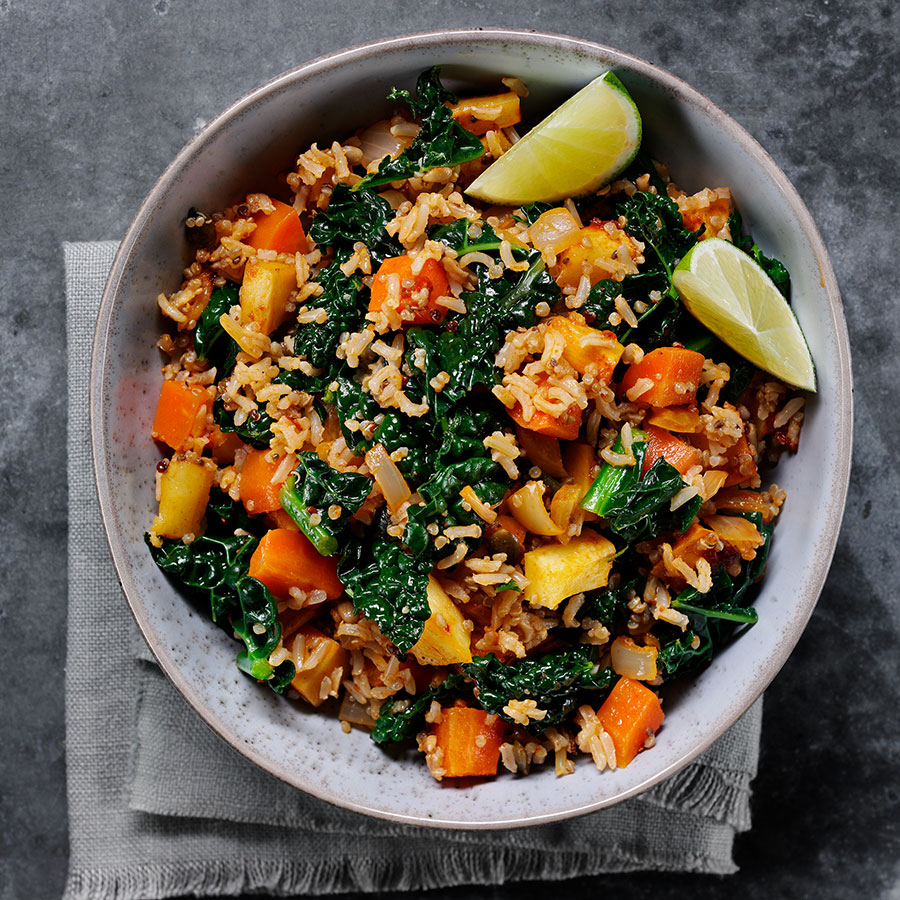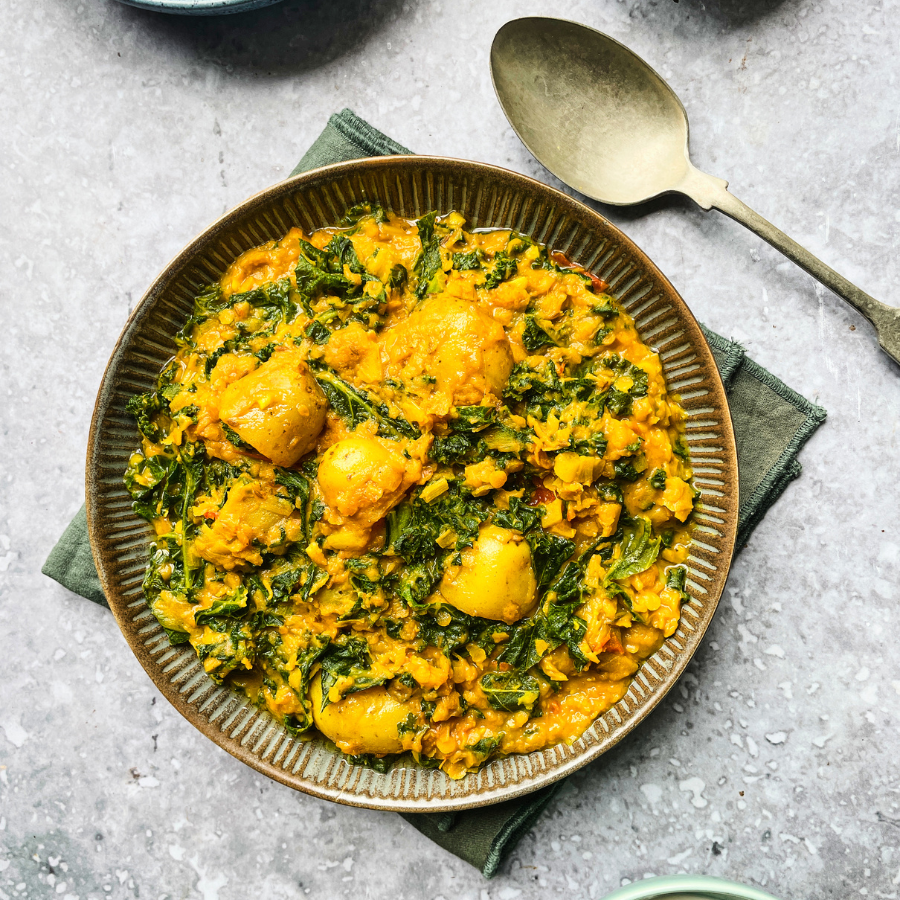Fibre is a nutrient that has far-reaching benefits - from supporting gut health[i] and improving mood[ii], to helping maintain a healthy weight and lowering the risk of cardiovascular disease, diabetes and bowel cancer[iii]. However, just 9% of us are getting enough fibre[1] – with the average adult consuming 19.7g a day, compared to the recommended 30g.
Discover these 5 fantastic fibre-packed recipes that include kale, cavolo nero, and spinach!
GINGER HARISSA ROASTED VEGETABLE PILAF (high in fibre: 24g of fibre per portion)

Prep: 15 minutes
Cook: 30 minutes
Serves 4
Ingredients
2 parsnips, diced
2 carrots, diced
1 onion, diced
2 tbsp olive oil
5cm piece root ginger, grated
1 tbsp harissa paste
200g pack sliced Cavolo Nero
250g pouch super seeds with quinoa & chia
200g brown basmati rice
Juice 1 lime
Yogurt to serve
Instructions
1. Preheat the oven to 200°C, gas mark 6.
2. Place the parsnips, carrot and onion on a large baking tray and toss with 1 tbsp oil, ginger and harissa, season and roast for 20 minutes. Add the cavolo nero, the seeds mix and toss in the remaining oil, roast for a further 10 minutes.
3. Meanwhile, cook the rice in boiling water for 20-25 minutes until tender and drain well.
4. Stir the rice into the vegetable mixture with the lime juice, season and serve with the yogurt.
Cooking tip: Great to use up leftover cooked rice. Try stirring in cooked prawns at the end.
WINTER KALE SALAD (21g of fibre per portion)
.png?updated=1730386333541)
Prep: 10 minutes
Cooks: 15-20 minutes
Serves 2
Ingredients
50g quinoa
2 tbsp extra virgin olive oil
1 tbsp cider vinegar
2 tsp wholegrain mustard 15g
½ x 180g pack Kale
400g can butter beans, drained and rinsed
1 red apple, cored and sliced
50g walnuts, chopped
1 ripe avocado, sliced 100g
80g cooked beetroot, cut into wedges
Instructions
1. Cook the quinoa according to pack instructions, drain and run under cold water.
2. Meanwhile, whisk together the oil, vinegar and mustard, season to taste. Massage the dressing into the kale in a large bowl until softened slightly. Add in the butter beans, apple, walnuts, avocado and beetroot.
3. Stir in the quinoa to serve.
Cooking tip: Make kale crisps with the remaining bag of kale, great as a healthy snack.
TOFU SPINACH AND BEAN SOUP (high in fibre: 19g of fibre per portion)
.png?updated=1730383403156)
Prep: 15 minutes
Cook: 30 minutes
Serves 4
Ingredients
1 corn on the cob 150g
1 tbsp olive oil
1 leek, sliced 200g
500ml vegetable stock
280g pack extra firm tofu, diced
400g haricot beans, drained and rinsed
½ x 250g bag Spinach
1 tbsp red pesto 20g
Juice half lemon
Instructions
1. Cut the kernels of corn off the core with a sharp knife.
2. Heat the oil in a large saucepan and fry the corn and leeks for 3-4 minutes until softened. Stir in the stock, tofu and beans and simmer, covered, for 5 minutes, add the Spinach until wilted.
3. Add a spoonful of pesto and a drizzle of lemon juice to serve.
Cooking tip: Try using smoked tofu and vegan pesto as an option.
CREAMY POTATO AND KALE CURRY (high in fibre: 18g of fibre per portion)

Prep: 5 minutes
Cook: 20 minutes
Serves 4
Ingredients
600g waxy potatoes, peeled and chopped into 1 inch cubes OR 600g salad potatoes (chopped in half if large)
2 tbsp veg oil
1 tsp cumin seeds
2 leeks, cleaned and trimmed
1 tsp turmeric
1 tsp ground coriander
3 garlic cloves, grated
1/2 tsp chilli flakes
5 tomatoes, roughly diced
200g red split lentils rinsed
500 ml veg stock
1 x 400ml low fat coconut milk
250g bag of kale, trimmed
1 tsp garam masala
Instructions
1. Add the potatoes in a large saucepan. Cover with boiling water and cook for 8-10 mins, or until just tender. Drain.
2. In the meantime, add the oil and cumin seeds to a frying pan. Allow them to sizzle to release their aromas.
3. Now add the leeks and remaining spices and fry for approx 5 minutes until tender.
4. Add the garlic and chilli flakes and stir to combine and fry for a further minute.
5. Add the chopped tomatoes and stir to combine.
6. Now add the red lentils, stock, coconut milk and simmer for 10 minutes.
7. Add the cooked potatoes, kale and additional water if needed (300ml) then cook for a further 5 minutes
8. Finally, season to taste and add garam masala
Cooking tip: This is a hearty and substantial dish so there’s no need for extra crabs. A vegetable side dish or raita is perfect. A great one for freezing.
KALE AND WALNUT PASTA PRIMAVERA (high in fibre: 13g of fibre per portion)
.png?updated=1730383403405)
Prep: 15 minutes
Cook: 30 minutes
Serves 4
Ingredients
250g wholewheat penne pasta
100g frozen broad beans
100g frozen peas
180g bag Kale
1 tbsp olive oil
1 leek, thinly sliced 200g
75g walnuts, roughly chopped
2 tbsp chopped chives
165g tub light cream cheese
25g Parmigiano Reggiano, finely grated, plus extra to serve
Instructions
1. Cook the pasta in boiling water for 12-13 minutes until just tender, remove with a slotted spoon and add the beans, peas and kale to the water, simmer for 4-5 minutes. Drain, reserving a little of the cooking water.
2. Meanwhile, heat the oil in a large frying pan and fry the leek and walnuts for 4-5 minutes until softened. Stir in the chives, cream cheese and the Parmesan, heat gently to melt, adding a splash of the reserved cooking water. Stir in the pasta and vegetables to evenly coat.
3. Serve sprinkled with extra Parmesan.
Cooking tips: Try any vegetables you may have in the freezer. Also a great way to use up leftover cooked vegetables.
[1] NDNS: results from years 9 to 11 (2016 to 2017 and 2018 to 2019) https://www.gov.uk/government/statistics/ndns-results-from-years-9-to-11-2016-to-2017-and-2018-to-2019
[i] Fu J, Zheng Y, Gao Y, Xu W. Dietary Fiber Intake and Gut Microbiota in Human Health. Microorganisms. 2022 Dec 18;10(12):2507. doi: 10.3390/microorganisms10122507. PMID: 36557760; PMCID: PMC9787832.
[ii] Saghafian, F., Hajishafiee, M., Rouhani, P., & Saneei, P. (2022). Dietary fiber intake, depression, and anxiety: a systematic review and meta-analysis of epidemiologic studies. Nutritional Neuroscience, 26(2), 108–126. https://doi.org/10.1080/102841...
[iii] Waddell, I. S., & Orfila, C. (2022). Dietary fiber in the prevention of obesity and obesity-related chronic diseases: From epidemiological evidence to potential molecular mechanisms. Critical Reviews in Food Science and Nutrition, 63(27), 8752–8767. https://doi.org/10.1080/104083...